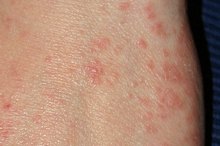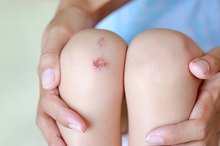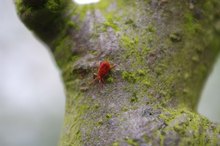What does fact checked mean?
At Healthfully, we strive to deliver objective content that is accurate and up-to-date. Our team periodically reviews articles in order to ensure content quality. The sources cited below consist of evidence from peer-reviewed journals, prominent medical organizations, academic associations, and government data.
The information contained on this site is for informational purposes only, and should not be used as a substitute for the advice of a professional health care provider. Please check with the appropriate physician regarding health questions and concerns. Although we strive to deliver accurate and up-to-date information, no guarantee to that effect is made.
How Long Can Scabies Eggs Live?
Once a human contracts the scabies "human itch" mite, he can be infested indefinitely as long as the condition goes untreated. The egg cycle of a female scabies mite is very short compared to her overall life cycle 1. Scabies eggs only exist for a short time, after which they hatch and go through two different incarnations before the adult mite is ready to breed and lay more eggs.
The Scabies Mite Finds a Home
All it takes is one impregnated female scabies mite to cause an entire infestation on the human body. Once the female mite finds a suitable habitat on the human host--generally where the folds of the skin touch each other, such as:
- the crooks of the elbow
- webbing of the fingers
- in between the shoulder blades,
- under the breasts--she forms a "burrow," where she begins to lay her eggs
The First Cycle
Early Scabies
Learn More
Scabies eggs take between three and four days to hatch. Three-legged larvae emerge and make their way to the skin's surface, forming shorter burrows called "molting pouches." The larval stage lasts between three or four days, after which the mite molts into a four-legged nymph.
The Adult Scabies Arrives
The scabies nymph again molts--this time into an adult mite who is ready to breed. The innocuous male mites linger in shallow pits in the skin, biding their time and feeding off the human host. Once mite finds mate, the newly-impregnated louse creates a new burrow of her own and begins to lay eggs. Scabies mites live anywhere between one and two months, during which time they lay two or three eggs daily. However, only ten percent of these eggs hatch. Most scabies infections are the result of a minuscule number of female scabies mites.
- The scabies nymph again molts--this time into an adult mite who is ready to breed.
Treating Scabies
Mange Treatment for Humans
Learn More
Scabies mites and their eggs can be effectively eradicated on the human body with use of scabicides containing permethrin or crotamiton. These topical lotions are left on the body for around eight hours, after which they are washed off.
Preventing Reinfestation
Although scabies cannot lay eggs anywhere else but in their burrow, they can survive for 72 hours without a human host. Even after a human infestation is eradicated, personal items such as linens, clothing and sheets need to be washed in hot water and dried on hot air. Items that cannot be laundered may be stored in plastic containers for a few days.
- Although scabies cannot lay eggs anywhere else but in their burrow, they can survive for 72 hours without a human host.
- Even after a human infestation is eradicated, personal items such as linens, clothing and sheets need to be washed in hot water and dried on hot air.
Related Articles
References
- Scabies Life Cycle
- Scabies. World Health Organization.. May 20, 2019.
- CDC - Scabies - Disease. Centers for Disease Control and Prevention. Nov 2, 2010.
- Harvard Health Publishing. Scabies. Harvard Health. Dec 2018.
- Mrázová Z, Jadrníčková I, Brabcová K, Spurný F. Fragmentation of Ne ions with energy 400 MeV/u behind targets from different materials measured with PNTD. Radiation Measurements. 2010;45(10):1438-1440. doi:10.1016/j.radmeas.2010.06.048.
- Patel VM, Lambert WC, Schwartz RA. Safety of Topical Medications for Scabies and Lice in Pregnancy. Indian J Dermatol. 2016;61(6):583-587. doi:10.4103/0019-5154.193659
- CDC - Scabies - Resources for Health Professionals - Medications. Centers for Disease Control and Prevention. Oct 2, 2019.
- CDC - Scabies - General Information - Frequently Asked Questions (FAQs). Centers for Disease Control and Prevention. Oct 24, 2018.
- Arlian LG, Morgan MS. A review of Sarcoptes scabiei: past, present and future. Parasit Vectors. 2017 Jun 20;10(1):297. doi: 10.1186/s13071-017-2234-1.
- CDC. Scabies. Resources for Health Professionals, Medications.
- Micali G, Lacarrubba F, Verzì AE, Chosidow O, Schwartz RA. Scabies: Advances in Noninvasive Diagnosis. PLoS Negl Trop Dis. 2016 Jun 16;10(6):e0004691. doi: 10.1371/journal.pntd.0004691. eCollection 2016 Jun.
Writer Bio
Lisa Sefcik has been writing professionally since 1987. Her subject matter includes pet care, travel, consumer reviews, classical music and entertainment. She's worked as a policy analyst, news reporter and freelance writer/columnist for Cox Publications and numerous national print publications. Sefcik holds a paralegal certification as well as degrees in journalism and piano performance from the University of Texas at Austin.









